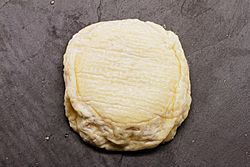Saint-Marcellin facts for kids
Quick facts for kids Saint-Marcellin |
|
|---|---|
 |
|
| Country of origin | France |
| Region, town | Isère, Rhone-Alpes |
| Source of milk | cows |
| Texture | creamy |
| Fat content | 50% |
| Certification | PGI (Nov. 2013) |
| Named after | Lua error in Module:Wikidata at line 70: attempt to index field 'wikibase' (a nil value). |
Saint-Marcellin is a delicious, soft French cheese. It is made from cow's milk. This cheese gets its name from a small town called Saint-Marcellin in France. It comes from a special area that used to be part of the old Dauphiné province. Today, this area is in the Rhône-Alpes region of France.
Saint-Marcellin cheeses are usually small. They weigh about 80 grams. They have a creamy-white outside that can look a bit spotted. As the cheese gets older, it becomes more runny. Its outside can also change color, turning blue and then yellow after a few weeks.
What Makes It Special?
Saint-Marcellin is quite similar to another cheese called Saint-Félicien. They have a similar feel and taste. However, Saint-Félicien is a larger cheese. It is made in a different part of the Rhône-Alpes region.
Different Kinds of Saint-Marcellin
You can find Saint-Marcellin cheese in three different stages of aging. This aging process is called affinage in French. The three types are:
- Sec: This means "dry." It's a firmer, less runny cheese.
- Crémeux: This means "creamy." It's softer and more runny.
- Bleu: This means "blue." This cheese has blue molds on its rind, giving it a stronger flavor.
Special Flavors
Sometimes, Saint-Marcellin cheese is aged in special liquids to give it unique flavors.
- When it is aged in a type of French brandy called marc brandy for a month or more, it is called Arômes au Gène de Marc.
- If it is aged in white wine, it becomes Arômes de Lyon.
See also
 In Spanish: Saint-Marcellin (queso) para niños
In Spanish: Saint-Marcellin (queso) para niños

